
![]() Commentary on the Karl-May movies in the U.S.A.
Commentary on the Karl-May movies in the U.S.A.
![]() Press Reviews: The Treasure Of Silver Lake
Press Reviews: The Treasure Of Silver Lake
![]() Press Reviews: Last Of The Renegades
Press Reviews: Last Of The Renegades
![]() Press Reviews: The Desperado Trail
Press Reviews: The Desperado Trail
![]() Press Reviews: Apaches Last Battle
Press Reviews: Apaches Last Battle
![]() Press Reviews: The Shoot / Yellow Devil
Press Reviews: The Shoot / Yellow Devil
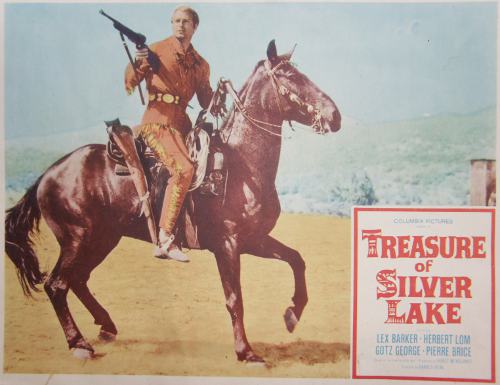
Commentary on the Karl-May movies in the U.S.A.:
At the very end of the Karl May movie series, Winnetou and Old Shatterhand ride in the Western's country of origin after all. During "Winnetou and Shatterhand in the Valley of Death" (1968) the viewer sees May's heroes ride along the Grand Canyon. And with that, the fantasy characters of the Saxon fiction writer have arrived in the 'Grand Canyon' at last. Even though doubles were used for the short scenes, and no Lex Barker or Pierre Brice sat on those horses, the ride in far away America nevertheless conveyed something mythical. The Winnetou Westerns with their fairytale style, and their actual filming locations only two flying hours away from Germany, in the Yugoslav Karst region, have made the leap to the United States of America, which many dreamt of, but not believed possible.
With that, the German filmmakers mirror their Italian colleague Sergio Leone, for whom the shoot in Monument Valley (Utah, USA) for Once Upon a Time in the West (1968) also represents the fulfillment of an old wish. Although Karl May's Western stories are better suited for the home market, because of their German origin, and their idealized Indian views, as well as their German heroes, the screen appearances of Old Shatterhand, Winnetou, Old Surehand, and even Old Firehand, have earned positive critiques in the Western's country of origin from the start. Thanks to the international cast and crew, as well as the professional design, Horst Wendlandt's Westerns have definitely created attention among the aficionados of the genre.
The Hollywood Western is undergoing a change during the early years of the 1960s. One of the more significant reasons for this is the triumphant advance of television with its many Western series, which prompts the American film industry to rethink the genre. The classic linear Western remains popular on the small screen. In the cinema, however, it is being replaced by productions with psychological overtones and plots of merciless vengeance. Concurrently, the German movie makers with their Winnetou productions follow the trails of the classic Western and make films with larger-than-life, classic Western heroes that have almost completely disappeared from view except in the motion pictures featuring Western institution John Wayne. American Lex Barker advances to the blond, strong-as-an-ox Old Shatterhand, and Frenchman Pierre Brice becomes the noble, peace loving Apache chief Winnetou. The success in Germany and Europe is huge; so big, in fact, that even Hollywood shows great interest in these movies. But then, Hollywood has always stayed informed about world-wide trends in the business.
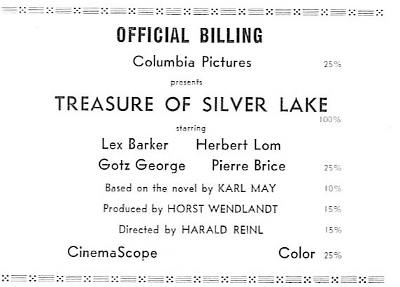
Trade journals such as Variety or The Hollywood Reporter write about the German Western wave right from the beginning in 1962. On top of this, there are the impressions of the Hollywood crew who work in Europe, or are visiting, and are sending reports about their experiences home. Forrest Tucker, for example, an experienced warrior in the American Western (cast at Lex Barker's side in "The Deerslayer", 1957), on the thirteenth of May, 1962 sends a postcard from Rome to Hollywood, and writes about a chance encounter with Lex Barker and Guy Madison in the 'eternal city'. Lex Barker had just signed the contract for the part of Old Shatterhand in the German Karl May films. During the get-together, there is the occasional remark about the upcoming Western of the 'Krauts'.
Interested readers learn more about the new Western pastime of the Germans a short while after the German opening of the debut production "The Treasure Of Silver Lake" on the twelfth of December, 1962.
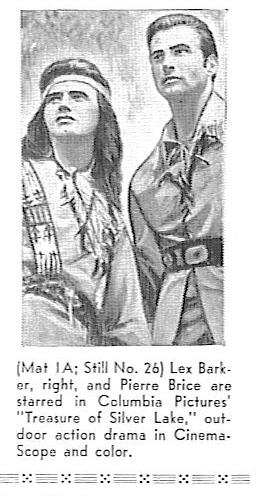
On the twenty-third of January, 1963*, Variety reports among other details that "[...] "The Treasure Of Silver Lake" commands attention for three reasons. It is the first big-scale CinemaScope German Western. It is the most expensive (about $875,000) film made by a Teutonic company in 1962. It is, within its special scope, a remarkably well made film. This contains the ingredients for a stout moneymaker within and outside its home grounds. There's a strong demand for such big-screen outdoor pictures and this one qualifies especially for patrons between 12 and 25. "Lake" admittedly doesn't reach the overall quality of Hollywood's top Westerns, yet it can compete with bulk of the stateside average outdoor epics. In fact, it's better than quite a few of them. Also, it doens't copy the Hollywood format while there are the usual fisticuffs and gunfire, but it has a more contemplative (European) touch. Like the big U.S. Westerns, this German-Yugoslav venture benefits from the great outdoors. The picturesque Karst region of the Titoland where the film was shot is hardly less impressive than the Arkansas region where the action occurs. The Eastmancolor photography enhances this production. The competent musical score adds to the mood. And there are the usual lovable and malicious Western characters [...] Barker, once an American Tarzan, is physically and ideally cast in the role of Old Shatterhand. He is always nice and sympathetic, and the Germans go for him. Barker is one of the few Yank screenplayers to click in German films. This is his fourth German-made find. And more are to follow [...] There's good reason to believe that "Silver Lake" will become one of Germany's most substantial postwar boxoffice contenders."
(* On the eight of January, 'Hans', stationed in Germany as the Journalist of the magazine, viewed the movie in Berlin.)
The success of the German Western does not remain hidden from the Americans. But more than two years will pass before the first Winnetou film will actually be shown in an American cinema. Columbia Pictures wins the race in the end and secures the rights for the USA. The owners of the studio, which belongs to the so-called 'majors', and which was founded in 1919 by brothers Jack and Harry Cohn, together with Joe Brandt, had been observing the foreign market during the previous years in search of suitable films for distribution. Several British movies, as well as Italian epics, have found their way into the States' cinemas that way. After Columbia pictures gets caught napping, and misses out on the James Bond movies despite previous cooperation with producer Broccoli (and also does not get the Sergio Leone Italo Westerns), the deal with Rialto producer Horst Wendlandt and the Western made in Germany is done. Variety reports on the first of September, 1965: "Columbia now has a total of five German-made Westerns on tap for future U.S. release. Its latest acquisition is "Winnetou and The Oil Prince", now winding producting. First of the German-made oaters to get a release here by Col are "The Treasure Of Silver Lake" and "Apache Gold"", which will be slotted separately on the lower halves of double bills. Also upcoming are "Winnetou II", which has been retitled ""Last Of The Renegades" and "Among The Vultures" (the German title translated), which has been retitled "Frontier Hellcat"."
The Karl May movies are marketed as B-Westerns. It means that they are presented together with another film in their category in a double feature. In order to heighten the interest for 'German Indian Westerns', the two first movies are introduced to the press in special viewing sessions on the twenty-forth, and twenty-sixth of August, 1965 in the Columbia Studios. The media kits that accompany the movies are indeed presentable. Catchy headlines are created: "Where the treasure turned blood-red with battle-fury!" ("The Treasure Of Silver Lake") or "An Adventure as big and violent as the wild land that spawned it!" ("Apache Gold").
Of course advertising concentrates on the actor Lex Barker, a fellow American, who is still a household name as Tarzan. His new character is being introduced in the trade journal of The Treasure of Silver Lake: "Old Shatterhand is a frontier adventurer, a doer of mighty deeds in the finest traditions of the West. The role is pretty much of a pattern for which Barker has become famous on the screen, and it is somewhat in keeping with his private life." (!) Next to Barker, Mario Adorf, who appeared in Sam Peckinpah's Western Sierra Chariba a year earlier ("[...] he looks Spanish-Mexican. He also looks completely villainous, which is one reason he is starred [...]"), and, of course, the internationally acclaimed Herbert Lom ("[...] has been many things in the course of his screen career; most of his characterizations have been as a 'baddie' [...]") receive attention. The publicity for Winnetou Pierre Brice is rather reserved.
Press Reviews: "The Treasure Of Silver Lake"![]()
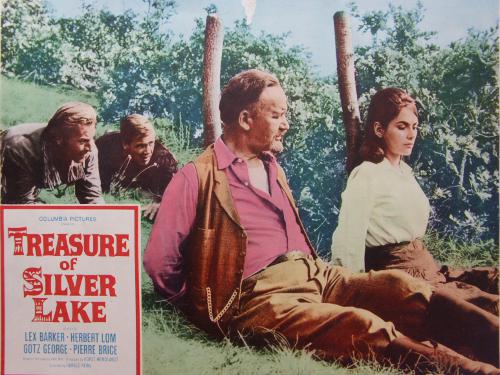
Variety, 26 August 1965: "European producers now are getting into the act of turning out Westerns for the American market. "The Treasure Of Silver Lake" carries plenty of oater action, what with stagecoach killings, search for a hidden treasure and Indians on the warpath, but sometimes it is a bit too refined. Most of the principals speak as though they've just graduated with a master's degree. Indian tribes, too, are scattered a little far afield from their hunting grounds, which probably will be picked up by youthful audiences here. All in all, however, the film, well photographed in CinemaScope and EastmanColor, is an okay entry for the Western trade. Lex Barker, only American in cast, is featured, with British thesp Herbert Lom portraying the heavy. Script by H.G. Peterson is based on a novel by Karl May, and some unusually spectacular scenic locations, fresh for American filmgoers, lend interesting backdrops, of which any Hollywood producer might well be proud.
Harald Reinl's direction, dull on occasions, is usually speedy, and sometimes the music score by Martin Bottcher, while generally properly atmospheric, is attuned to tender romance rather than the good guys and the bad trying to reach the treasure of Indian gold first. Plot development, at times on the ragged side, is sufficiently straightforward to maintain interest, particularly since there are such favored episodes as a knife duel between Barker, playing a gun-toting plainsman, and an Indian chief, attacks on a stockade and Indian charges.
Barker turns in a well-rounded characterization that would qualify in any American Western, and Lom handles his heavy in expected style. Pierre Brice is colorful as Barker's Apache companion, Goetz George is a stuffy hero handicapped by dialog and Karin Dor is in for distaff interest. Balance of supporting players are okay, but some of the Indians are scarcely authentic. Technical credits are headed by Ernest W. Kalinke's expert color camera work."
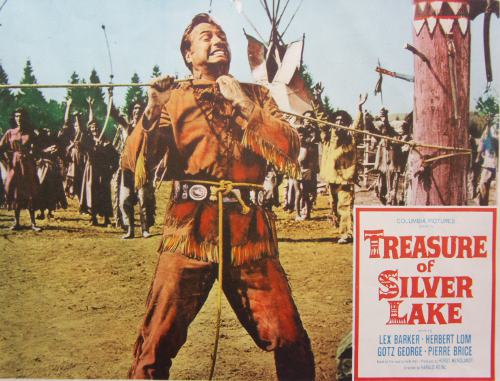
Hollywood Reporter (James Power), 26 August 1965: "[...] The new rule seems to be: a rock is a rock, a creek is a creek — shoot it in Dubrovnik. The Columbia release of the Rialto Preben Philipsen-Jadran production won't set any box-office records, but it will do nicely in markets geared to the Western action film. "The Treasure of Silver Lake" is from a book by Karl May, the German writer who achieved a vast success in German-speaking Europe with his stories of the American West, which he never saw. He was the combined Zane Grey-Edgar Rice Burroughs of middle Europe. "Silver Lake" is often naive in its treatment of the Wild West, but it has considerable charm. Lex Barker plays the hero, a scout called Old Shatterhand. His ally is Winnetou, a young chief of the Apaches. They are interested in protecting an Indian treasure (May got mixed up here with the Aztecs) coveted by some evil white men led by Herbert Lom. There is a lot of action, including an Indian assault on a wagon train and another on a stockade, and the producers of "Silver Lake" seem to have had access to almost unlimited Yugoslav redskins, so it makes for some big scenes. Most, if not all, the players are dubbed, including the English-speaking ones, so there is an artificiality about the film. The dubbing is better than most such jobs. Barker is capable as the central figure, and Lom is properly frightful as the menace [...] The mountain backgrounds are reasonably accurate substitutes for the American West, with a cactus stuck around here and there. Diehard students of novelties in films might to worse than spend 80 minutes observing this study of the American West as seen through the long-distance lens of a German writer and later European film-makers."
The Film Daily (Mandel Herstman), 27 August 1965: "[...] The story has its interesting elements dealing with the lust for a hidden trasure of gold. The action, gunplay and excitement generated will please the average fan. The observant patron will find scatterings of cliches [...]".
Boxoffice, 13 September 1965: "[...] American star Lex Barker portrays Old Shatterhand, heroic do-gooder who hunts badmen with a magic rifle which shoots silver bullets [...] Performances are generally good, English language dubbing is adequate and director Harald Reinl keeps proceedings moving at a rapid clip. Production values, barring some distinctly European scenery, are excellent and the color processing is unusually fine."
Motion Picture Herald (Sy Oshinsky), 15 September 1965: "For those who still prefer a Western with a flawless hero, incurable villians, brave Indian warriors and a fair frontier maiden in distress, there is "Treasure of Silver Lake" to recommend. Stripped of psychological nuances and other frills that have been added over the years to make the Western more "adult", this film presents a hard West, with bullets and arrows constantly flying in all directions. That it was made in Europe largely with foreign actors may explain why the film appears to ignore the many changes that Westerns have undergone over the years [...] What this all means is that youngsters should have a happy time with this old-style wild Western, and other audiences will have something to reminisce about [...]".
Press Reviews: "Apache Gold"![]()
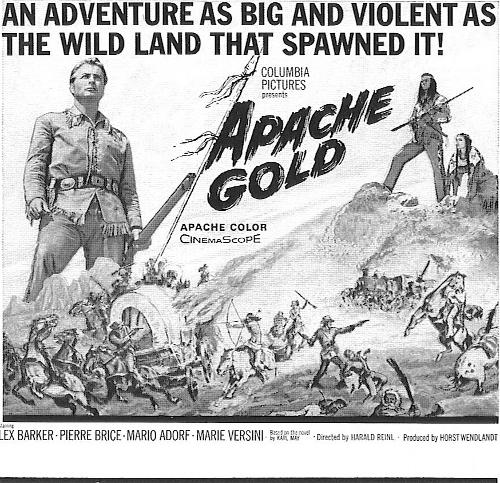
Variety, 12 Dezember 1963: "To begin with, there's something quite amusing about Karl May's "Winnetou". As "the big chieftain of the Apaches", he has become an immortal figure with millions of Germans who read Karl May's adventure literature. But in the country where he "lived", in the good old U.S., Winnetou is unknown. [...] Rather amusing, of course, is the fact that German film producers have become Western-minded and that they're able to turn out Western film fare that's both exciting and non-stop fun. This applies to "Winnetou" [...] it is better than "Silver Lake" in nearly every respect. What seemed unbelievable a couple a years back has become reality: That Germans can make Westerns that are able to compete with bulk of the Hollywood average Westerns. Horst Wendland, who supervised the whole production, was well advised not to pattern the picture along a strict Hollywood pattern. The Rialto topper took care that "Winnetou" was given a substantial European touch and "a romantic German smell". This, as strange as it may sound, makes "Winnetou" something special. It's a refreshing picture. This is a film for the entire family. The conventional forms of sex, sadism and brutality are deliberately absent in this production [...] More or less everyone comes along with a refreshing performance: Lex Barker, the most prominent American in German pictures today, is right at home with his Shatterhand role. He's tall, blond, heroic, very much masculine and likeable. No doubt, this picture will bring him even more friends in Germany. Pierre Brice, a French actor, enacts Winnetou in an effective manner. Brice, a special favorite with the Teutonic bobbysox set, should blimb the ladder of popularity after this [...] The question is: will "Winnetou" do as well outside Germany? One feels that it will."
Variety, 31 August 1965: "[...] Director Harald Reinl keeps action moving at breakneck pace, and shoot-out sequences should satisfy action devotees. With U.S. thesp Lex Barker in lead and Europeans in remainder of cast, pic has built-in appeal to many markets. Some errors of time and place occur — Apaches use birchbark canoes and live by idyllic waterfall — but slips probably are no worse than in old Grade B products [...] In fact, all Yugoslav terrain on which pic was shot was well-chosen despite the waterfall. Art director Vladimir Tadej turned out authentic sets which seem to indicate careful study of old photos of railroad-building era."
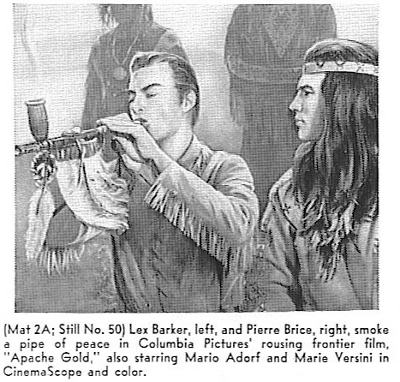
The Hollywood Reporter (James Powers), 31 August 1965: "[...] "Apache Gold" is a good Western for fans of the type [...] Lex Barker is seen as May's hero, "Old Shatterhand", and in "Apache Gold", he gets his introduction to the West and the characters who were staples of May's work [...] There is some good action footage. Particularly effective is the camera work on the big battle scenes, tracking shots that would be a credit to experienced American cameramen. [...]"
The Film Daily (Mandel Herbstman), 9 September 1965: "[...] The ingredients are the familiar ones. The action is good, the plot simple. Scenic outdoor shots in Eastman Color by Pathe are quite striking. Fans should receive the film favorably [...] In the good guy role is quick, trim Lex Barker [...]"
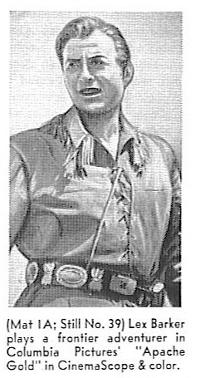
Boxoffice, 13 September 1965: "This German-made variation on the American horse opera has enjoyed phenomenal popularity in Europe where it was known as "Winnetou". Success is sure to be duplicated here with family audiences and action fans of all ages for the breathtakingly beautiful Eastman Color and CinemaScope production is unusually lavish and the fast-moving story is rich in audience-pleasing elements of action, adventure and romance. Also, performances by star Lex Barker, a former Tarzan, and the European supporting players are uniformly excellent, with dubbing so fine that few viewers will be aware of the film's foreign origin [...]".
Motion Picture Herald (Sy Oshinsky), 15 September 1965: "Western buffs will like the ruggedness of the characters and the background caught in color by the cameras in "Apache Gold". Although produced by European filmmakers, and shot in Yugoslavia, "Apache Gold" manages to convey the spirit of the Old West quite effectively [...]."
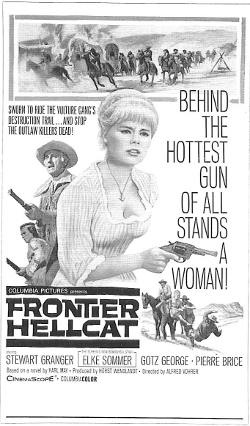
After the two Winnetou movies with Old Shatterhand Lex Barker, Columbia Pictures also releases Old Surehand Stewart Granger into the US Cinemas the following year. With former Hollywood Star (King Solomon's Diamonds, Scaramouche), leading the cast, the movies Frontier Hellcat, and Rampage at Apache Wells, are easily marketed. The American critiques for these, as well as those for the Old Firehand movie with Rod Cameron, are featured on Marlies Bugmann's website 'Friends of Karl May' http://australianfriendsofkarlmay.yolasite.com/.
The next Old Shatterhand movie with Lex Barker to be released in his homeland
is Last of the Renegades (Winnetou II), which
premieres in the States in September, 1966. The movie is promoted as a great
Indian Western, whereby Winnetou receives a little more room in the publicity: "NOW ALL THE TRIBES WERE GATHERED: Apaches ![]() Crows
Crows ![]() Cheyennes
Cheyennes ![]() Poncas
Poncas ![]() Mandans
Mandans ![]() Sioux
Sioux ![]() Navajos
Navajos ![]() Osages
Osages ![]() Pawnees
Pawnees ![]() Chippewas
Chippewas ![]() Shoshones
Shoshones ![]() Assiniboins
Assiniboins ![]() Dakotas ...
and at the head of them all WINNETOU Chief of Chiefs, Warrior of Warriors!"
The peaceful Winnetou is turned into an infamous warrior.
Dakotas ...
and at the head of them all WINNETOU Chief of Chiefs, Warrior of Warriors!"
The peaceful Winnetou is turned into an infamous warrior.
Although Columbia pictures once more publishes a good selection of press material for this movie, the conclusion to the Winnetou trilogy, with the headline 'A Trail Of A Thousand Dangers!', the echo of the media (as well as the interest of the public) for the films is clearly weakening. The trend is shifting towards the hard Italo Western. Nevertheless, the critiques of Variety offer interesting insights into the Old Shatterhand movies with Lex Barker.
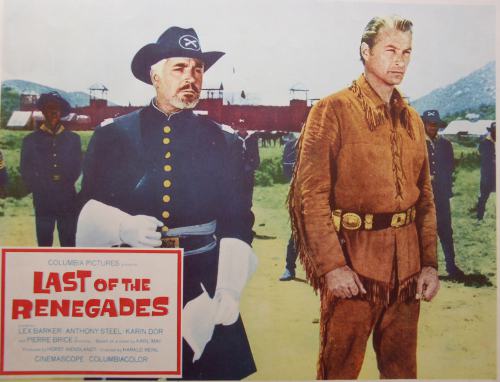
Winnetou's death in "The Desperado Trail" (Winnetou III) hits the American cinemas in 1967. Artur Brauner's Old Shatterhand, which is distributed under the title of Shatterhand by Goldstone Film Enterprises, is shown as early as October 1967 in Los Angeles. Head of the distribution company is none other than the young Brit John Goldstone, who will later become famous with the production of the Monty Python movies.
The (temporary) finale of the Winnetou presentations in American cinemas comprises Thunder at the Border, for which Columbia Pictures has world-wide distribution rights, with Hollywood Western veteran Rod Cameron as Old Firehand, and US cinema debut date of November 1967; as well as Flaming Frontier (Old Surehand I), again with Stewart Granger as Old Surehand, and a US premiere of February, 1968. After the term of the film deal with Columbia Pictures has expired, this Rialto Film production will be distributed by Warner Bros.
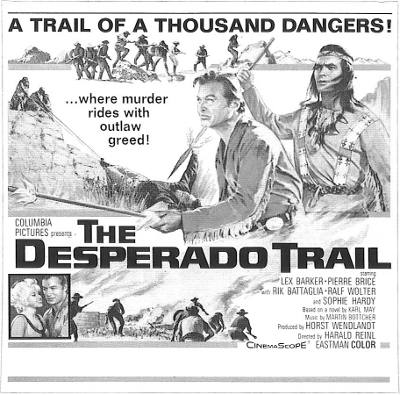
And with that, the story of the Winnetou movies in the American cinemas is almost told. But Winnetou and Old Shatterhand find their way there one last time. At the beginning of 1973, two movie enthusiasts, Robert Saxton and Roy Molina, establish a new company, Hampton International, which will last until about 1975. They specialize in the distribution of European genre movies. Kommissar X movies and Edgar Wallace productions are listed on their programme, as is "The Half-Breed". Screen dates during several months are evident. The publicity headlines read: "Action! The Apaches are the good guys!"
More Karl May movies with Lex Barker on American silver screens have (thus far) not been found. The finale of the Winnetou series, "Winnetou and Shatterhand in the Valley of Death", with the short scene of the Grand Canyon has — most likely — not made it into the US cinemas. In its stead, the trails of another film can be found in television programs. The Treasure of the Aztecs is listed in a TV magazine from 1971. Various Rialto Film productions continue to be screened occasionally. They have even made it into the respected classics channel TCM (Turner Classic Movies) in more recent times, including commentary by renowned film expert Robert Osborne.
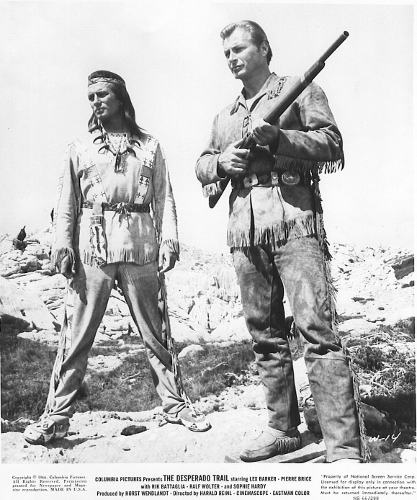
The following are quotes from critiques of the movies from Winnetou II onwards. One further Karl May film critique is dedicated to the Orient adventure The Shoot/Yellow Devil.
Lex Barker was definitely accepted in the country of origin as the Westerner Old Shatterhand in the German Karl May movies. The pictures were generally understood to be entertainment fare that brought a breath of fresh air into the Western. Having a native Indian on equal footing with a White is a pleasing element that Hollywood discovers only much later (with a few exceptions). Shatterhand Lex Barker definitely fits onto the list of noted high-calibre Westerners like Audie Murphy, Hugh O'Brian, Guy Madison, or Ronald Reagan. In fact, German Western hearts beat somewhat higher for Barker than for any of the others.
"A German Western? That will never work!" Lex Barker commented when he was first confronted with the role of the Karl May hero. His skepticism experienced an about turn through the overwhelming success of the movies in Germany and Europe. The fact that the films found their way into the homeland of the American Western is in no small part thanks to Lex Barker; and he deserves to be honoured for that!
Press Reviews: "Last Of The Renegades"![]()
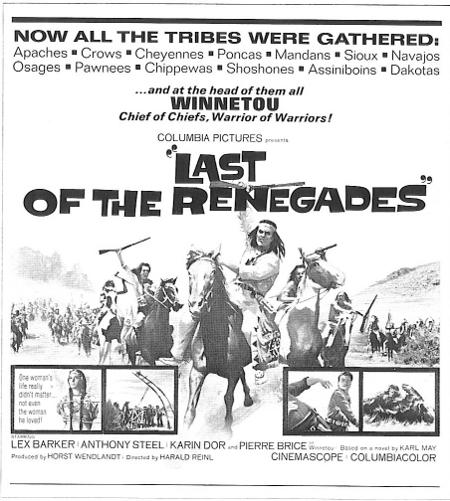
Variety, 11 April 1964: "Horst Wendlandt has done it again: Another big-scale Teutonic "Western" made in Yugoslavia with an international cast headed by Lex Barker, Pierre Brice and (new to the German screen) Anthony Steel [...] As often goes with pictures made in series, this is not as fresh as its predecessors. Also, characters, situations and complications have become a bit too familiar, a drawback for which the scriptor, Harald G. Petersson, must bear responsibility. Yet also "Winnetou, Part II" has its advantages [...]"
Press Reviews: "The Desperado Trail"![]()
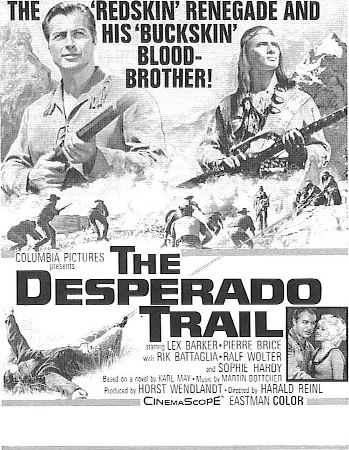
Variety, 19 Januar 1966: "Winnetou, Part III" puts an end to Winnetou; that handsome, mild talking chieftain of the Apaches gets shot in the 83rd minute of this Rialto production. Remainder of the film is a tear-jerker for the many Winnetou fans. And never has one seen Old Shatterhand alias Lex Barker, Winnetou's lifelong friend, looking so serious on the screen. There seems little doubt that this German-Yugoslav Karl May Western will spell a lot of coin throughout the country. Also this one will sled into many foreign markets. Horst Wendlandt, the initator and general supervisor of these Teutonic horse operas, has never had any complaints about their foreign sales. The third and final part of the "Winnetou" films offers more fights, violence and blood than the previous Rialto productions. It gives clear evidence of the fact that creators of this series have gained much knowhow about fisticuffs, saloon brawls and gunfights [...] Frenchman Pierre Brice plays his Winnetou part in the manner which has made him an idolized screen hero with seemingly millions of native youngsters. Same goes for American Lex Barker who is "delightfully" robust with regard to handling his various opponents [...] Director Harald Reinl has found an appealing mixture of brutality, humor and sentiment which pleases large segments of the not too demanding Continental film patrons. He takes care that the whole thing remains very much on the romantic side [...]"
Press Reviews: "Apaches Last Battle"![]()
Variety, 22 Januar 1964: "For the record, this is Artur Brauner's first big-scale Western [...] Supervised by Brauner, this is truly an international vehicle. Headed by Americans Lex Barker and Guy Madison, French Pierre Brice and Israeli beauty Daliah Lavi, the cast is composed of American, French, Italian, Yugoslav and German players. Similar variety of nationalities applies to the staff of this venture. And an American, Hugo Fregonese, directed. Although one can find many faults with "Old Shatterhand", there is no denying that this "German Western" will spell much coin in this country. And taking into account that action pictures of this type find adherents everywhere, it should do well elsewhere, the more so because director Hugo Fregonese has given this the typical American action slant. There is sure to be an inclination to draw comparisons between "Old Shatterhand" and its native predecessors, "Treasure of Silver Lake" and "Winnetou, Part I" two Rialto productions which have become mammoth moneymakers in Germany. And there is a difference. Brauner's horse opera concentrates more on violence and also has sex in the form of Daliah Lavi to offer. There is even an attempted rape in this film [...] Hugo Fregonese's direction of the battle sequences reveals much knowhow. Lex Barker is once more the grim but friendly hero, Old Shatterhand, while Pierre Brice is the handsome Apache chieftain. Guy Madison portrays Captain Bradley, one of the top villians. It's his Teutonic screen debut [...] It's first time that the 70m Superpanorama was used in a Karl May vehicle. There are impressive shots of the beautiful Yugoslav country which provided the "American background" for this European Western."
Press Reviews: "The Shoot / Yellow Devil"![]()
Variety, 4 November 1964: "Another large-scale German-Yugoslav Karl May filmization, again with Lex Barker as the Teutonic hero, this one has an Oriental background. There is no denying that Hollywood is doing such adventurous things much better. Yet there seems little doubt that this one will collect a lot of coin in this country. Karl May, still much in vogue around here, is a powerful box office guarantee. Robert Siodmak, the German American who returned from Hollywood several years ago, directed "Der Schut" with a twinkle in his eyes. Wisely enough, the adventurous plot is not taken too seriously. And there is a substantial portion of comedy relief to balance with the suspense. A dozen years ago, Siodmak made "The Crimson Pirate", an adventure yarn which combined suspense and comedy. This contains much the same ingredients, but the outcome is not too similar. Real flaw in this one is a rather superficial script. Although the experienced hand of the director is evident in many sequences, there is little imagination [...] The beautiful Yugoslav rocky mountains supply the background for this adventure pic, certainly as asset. Martin Boettcher wrote the occasionally full-sounding score, another plus.
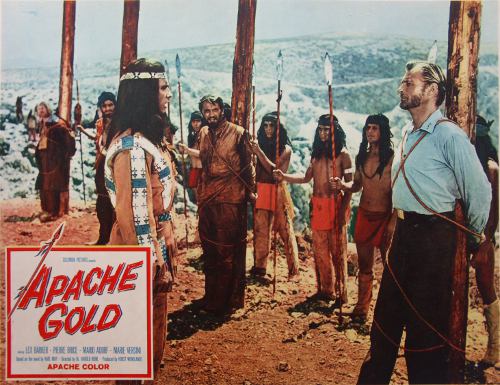
For their kind research assistance we thank Kristine Kreuger (Margaret Herrick Library, Academy of Motion Picture Arts and Sciences, Los Angeles) and Prof. Edward Comstock (Cinema Library, University of Southern California, Los Angeles).
Sources:
